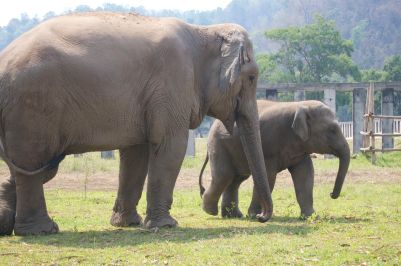I recently posted a (hopefully) delightful, if not inspirational, synopsis of my recent return to the Elephant Nature Park in Chiang Mai. I have some additional, more controversial thoughts that I thought I’d save for a separate post. So here goes.
I talked about how visiting the Elephant Nature Park is uplifting because of the contact and connection with beautiful, graceful, and gigantic creatures, yet sobering because of the stories of abuse those animals carry with them. When one has such an experience—both inspirational and heartbreaking—it’s tempting to become judgmental. During both my visits, I had heard other tourists ask, “What’s wrong with these people? How can the elephant be so sacred to Thai culture but so misused?”
I’ve contemplated this question quite a bit. And I think I have a possible explanation. It’s rather simple: poverty. It’s a matter of hierarchy of needs. It’s not as easy to take an idealistic perspective about the treatment of all living things when your own life hangs so dangerously in the balance. And desperation often leads to desperate action.
A good way to illustrate this is by examining the mahouts themselves. On the one hand, you have the logging mahouts, who resort to violence and abuse to punish the undesired behavior of elephants. On the other hand, you have the Elephant Nature Park mahouts, who reward desired behavior with food. When they want an elephant to go somewhere, they lead them with food. When they need to calm a distressed elephant, they placate them with food.
In my estimation, a stick or a hook is much cheaper than several tons a day of watermelon and bananas. There are two concepts in practice here: for-profit businesses will often seek the lowest bottom line even at the expense of living things, and people will almost always prioritize themselves over others. Moreover, it seems to me that the fight for the humane treatment of animals needs to happen alongside the fight to end human suffering.
It’s easy for Westerners to point the finger, while ignoring the fact that much of the prosperity that fosters their “enlightened” attitude towards animals stems from a history of exploitation of other people, particularly nonwhite people. This is not to excuse the actions of elephant abusers. Far from it. Many of them are probably cognizant of the degree of suffering they cause to these wonderful creatures. But perhaps they continue to do it because life must go on and quotas need to be filled. Who knows? Maybe they even regret it. Maybe it even keeps them up at night. All I’m arguing is that compassion should be universal to all species, including our own.
It’s important to fight for the lives and dignity of the innocent and defensive, no matter what species they are. So the efforts of the Elephant Nature Park are nothing but admirable and inspirational. But for me the inspiration doesn’t end with the story of the animals. I find it inspirational that a woman whose father was a healer in her humble village could have acquired the means to purchase over 60 acres of land, as well as the elephants themselves from their abusers.
Can you see the parallels here? In the same way fighting for the rights and dignity of animals involves a fight for the rights and dignity of people, the stories of rescuing those animals from abuse don’t start or end with the animals themselves. I reject the divide we place between nature and humanity. We’re linked. It’s a denial of that link that has led to such atrocities to begin with. Once we embrace that link, we can begin to solve the problems that face animals and humans alike.








